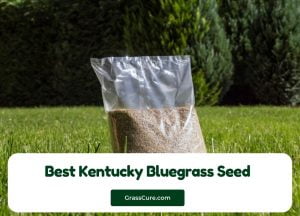If you’re looking to plant a new lawn, you may be wondering how long for Kentucky bluegrass to germinate. The good news is that Kentucky bluegrass is a relatively fast-germinating grass and typically takes between 7 and 14 days to sprout. In this blog post, we will discuss the successful germination of your Kentucky bluegrass lawn!
Contents
Understanding Kentucky Bluegrass Germination
The Germination Process
Kentucky Bluegrass (Poa pratensis) seeds are small, typically 2 to 3 mm in diameter, and exhibit a unique structure. Each seed consists of an outer protective layer called the seed coat, which encapsulates the embryonic plant. Inside the seed, there is an embryo with a shoot (plumule) and a root (radicle). Understanding this structure is crucial for comprehending the germination process.
Kentucky Bluegrass germination is highly influenced by environmental conditions. Several key factors play a role:
Temperature: Ideal germination temperatures range between 60 to 75 degrees Fahrenheit (15 to 24 degrees Celsius). Germination can occur at lower temperatures, but it may take longer.
Light: Kentucky Bluegrass seeds do not require light for germination and often germinate best when buried in the soil.
Moisture: Adequate moisture is essential for the initiation of germination. However, excessive water can lead to issues such as fungal diseases.
Ideal Conditions for Kentucky Bluegrass Germination
Temperature and Climate Considerations
Optimal Temperature Range: As mentioned earlier, maintaining soil temperatures between 60 and 75 degrees Fahrenheit is crucial for successful germination.
Climate Adaptability: Kentucky Bluegrass is well-adapted to cool-season climates, thriving in regions with cold winters and moderate summers.
Soil Requirements
Well-Drained Soil: Kentucky Bluegrass prefers well-drained soil to prevent waterlogging, which can impede germination.
Soil pH: The ideal soil pH for Kentucky Bluegrass is slightly acidic to neutral, ranging between 6.0 and 7.0.
Watering Practices
Consistent Moisture: While consistent moisture is essential for germination, overwatering should be avoided to prevent issues such as seed rot or fungal diseases.
Watering Frequency: Watering frequency may vary depending on environmental conditions, but the goal is to keep the soil consistently moist until germination occurs.
Germination Timeline
General Timeline for Kentucky Bluegrass Germination
Germination is a dynamic process influenced by various factors, and while Kentucky Bluegrass typically follows a general timeline, individual circumstances may lead to variations. Understanding the stages of germination can provide valuable insights into what to expect during the establishment of your lawn.
Initiation Phase (Days 1-5):
Kentucky Bluegrass seeds begin to imbibe water, initiating the germination process. The seed coat softens, allowing the radicle (embryonic root) to emerge.
Radicle Emergence (Days 5-10):
The radicle continues to elongate and grows downward into the soil. The first visible sign of germination, as the radicle becomes more pronounced.
Shoot Emergence (Days 10-14):
The shoot or plumule emerges above the soil surface. At this stage, the grass seedlings are establishing their presence.
Leaf Development (Days 14-21):
The first true leaves appear, marking the beginning of active photosynthesis. Seedlings focus on developing a strong root system and establishing initial foliage.
Establishment and Maturation (Weeks 3-6):
Seedlings continue to develop, with an emphasis on root growth and shoot maturation. The grass plants become more resilient and better able to withstand environmental stress.
Factors Influencing the Germination Period
Seed Quality:
High-quality, viable seeds will generally germinate more consistently and quickly. Ensure you purchase certified Kentucky Bluegrass seeds from reputable suppliers.
Maintenance Practices:
Adequate soil preparation and proper seeding techniques contribute to a favorable germination environment. Regular monitoring and timely adjustments can positively impact the germination timeline.
Understanding this general germination timeline provides a foundation for managing expectations and planning subsequent lawn care activities. It’s important to note that patience is key, and variations may occur based on environmental conditions and the specific characteristics of the Kentucky Bluegrass variety being cultivated. Regular monitoring and adjustments to care practices will contribute to a successful and vibrant lawn establishment.
Caring for Germinating Kentucky Bluegrass
Once Kentucky Bluegrass seeds have successfully germinated, providing proper care is crucial to ensure healthy seedling development and the establishment of a robust lawn. This stage requires attention to watering, fertilization, and overall maintenance practices.
Watering Schedule
Initial Watering After Seeding
Consistent Moisture: Maintain consistent soil moisture during the first few weeks after germination. Water lightly but frequently to prevent the soil from drying out.
Avoid Waterlogging: While moisture is essential, overwatering can lead to issues such as root rot and fungal diseases. Ensure proper drainage to prevent waterlogged conditions.
Subsequent Watering Practices
Transition to Deep Watering: As seedlings mature, gradually transition to deeper and less frequent watering. This encourages the development of a robust root system.
Monitor Environmental Conditions: Adjust watering frequency based on weather conditions. Hot and dry periods may necessitate more frequent watering.
Fertilization During Germination
Choosing the Right Fertilizer
Starter Fertilizer: Consider using a starter fertilizer with a balanced ratio of nitrogen, phosphorus, and potassium to support early seedling growth.
Avoid Excessive Nitrogen: While nitrogen is essential, excessive amounts can lead to issues. Choose a fertilizer with a moderate nitrogen content.
Timing and Application Methods
Initial Application: Apply the first round of fertilizer a few weeks after germination, once the seedlings have established.
Follow Manufacturer Guidelines: Adhere to the recommended application rates provided by the fertilizer manufacturer.
Avoid Herbicides: During the early stages of germination, it’s advisable to avoid herbicides that could negatively impact the developing seedlings.
Protection from Stressors
Minimize Traffic
Limit Foot Traffic: Minimize walking or other activities on the lawn during the early stages of germination to avoid compacting the soil.
Postpone Heavy Activities: Delay heavy lawn activities, such as aerating or dethatching, until the grass has fully established.
Monitor for Pests and Diseases
Vigilant Observation: Keep an eye on the lawn for signs of pests or diseases. Early detection allows for prompt intervention.
Appropriate Treatments: If issues arise, use targeted treatments that won’t harm the developing grass.
Caring for germinating Kentucky Bluegrass involves a combination of proper watering, timely fertilization, and strategic mowing practices. Patience and attention to detail during this critical phase contribute to the development of a lush and resilient lawn that will thrive for years to come.
Common Issues
Establishing a Kentucky Bluegrass lawn involves careful attention to detail, but despite best efforts, challenges may arise during the germination and early growth stages. Identifying and addressing common issues promptly is essential to ensure the success of your lawn project.
Identifying and Addressing Poor Germination
Uneven Germination:
- Cause: Uneven soil moisture, temperature fluctuations, or poor seed-to-soil contact.
- Solution: Ensure even watering, maintain consistent soil temperatures, and use proper seeding techniques.
Sparse Grass Coverage:
- Cause: Insufficient seeding rates, uneven seed distribution, or poor soil preparation.
- Solution: Increase seeding rates, use proper seeding techniques, and ensure thorough soil preparation.
Disease Issues:
- Cause: Fungal diseases can hinder germination, especially in overly wet conditions.
- Solution: Improve drainage, avoid overwatering, and consider fungicide treatments if necessary.
Dealing with Environmental Challenges
Pest Infestations:
- Cause: Insects such as grubs or birds can damage germinating seeds.
- Solution: Monitor for pests regularly and apply appropriate treatments if an infestation is detected.
Weed Competition:
- Cause: Weeds can compete with young grass seedlings for resources.
- Solution: Regularly inspect and manually remove weeds. Consider pre-emergent herbicides, but use them cautiously during the early stages.
Extreme Weather Conditions:
- Cause: Unfavorable weather conditions, such as excessive heat or heavy rain, can stress young seedlings.
- Solution: Provide shade during intense heat, improve drainage in waterlogged areas, and protect seedlings from extreme weather when possible.
Post-Germination Care Adjustments
Fine-Tuning Watering Practices:
- Cause: Changes in weather conditions may necessitate adjustments to the watering schedule.
- Solution: Monitor soil moisture regularly and adapt watering frequency based on environmental conditions.
Fertilization Issues:
- Cause: Overapplication or underapplication of fertilizer can impact grass health.
- Solution: Follow recommended fertilizer application rates and schedules. Adjust as needed based on visual cues from the lawn.
Reassessing Lawn Care Strategies
Reviewing Maintenance Practices:
- Cause: Inconsistent or improper maintenance practices may contribute to ongoing issues.
- Solution: Conduct a thorough review of maintenance practices, adjusting as needed based on the specific challenges encountered.
Consulting with Experts:
- Cause: Persistent issues may require professional advice.
- Solution: Seek guidance from local agricultural extension services or lawn care professionals to diagnose and address complex problems.
Troubleshooting common issues during the germination and early growth stages is a critical aspect of establishing a healthy Kentucky Bluegrass lawn. By being vigilant, proactive, and responsive to the unique needs of your lawn, you can overcome challenges and set the stage for a vibrant and thriving green space.
Conclusion
It takes Kentucky bluegrass about 21 days to germinate. However, this can vary depending on the conditions. If the temperature is too cold, it can take up to a month. If the temperature is too hot, it can take as little as two weeks. The best way to ensure that your grass will germinate properly is to plant it in the spring or fall, when the temperatures are moderate.
Some Related FAQs:
How long does it take for Kentucky Bluegrass to germinate?
Kentucky Bluegrass typically germinates within 14 to 30 days under optimal conditions, with factors like temperature and seed quality influencing the timeline.
Can I use Kentucky Bluegrass seed for overseeding an existing lawn?
Yes, Kentucky Bluegrass is suitable for overseeding, helping to enhance an existing lawn’s density and color. Ensure proper preparation and follow recommended seeding rates.
Should I mow newly germinated Kentucky Bluegrass seedlings?
Delay mowing until seedlings reach 3 to 4 inches in height. Gradually reduce mowing height in subsequent sessions to avoid stressing young plants.
What is the best fertilizer for germinating Kentucky Bluegrass?
Choose a starter fertilizer with a balanced NPK ratio, promoting healthy root and shoot development. Follow recommended application rates and timing.
How do I address patchy germination in my Kentucky Bluegrass lawn?
Patchy germination may result from uneven watering or poor soil contact. Reseed thin areas, improve watering consistency, and ensure proper seed-to-soil contact for better results.




